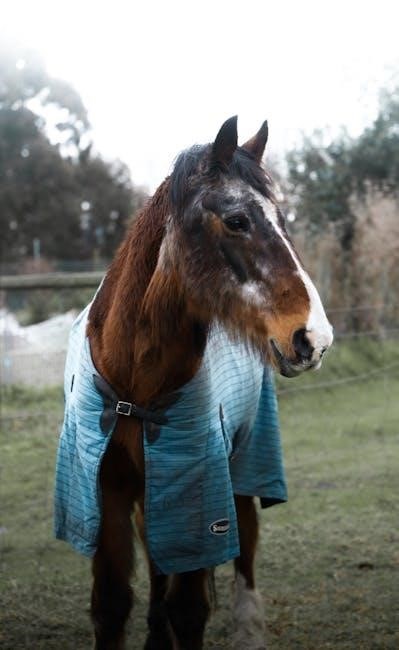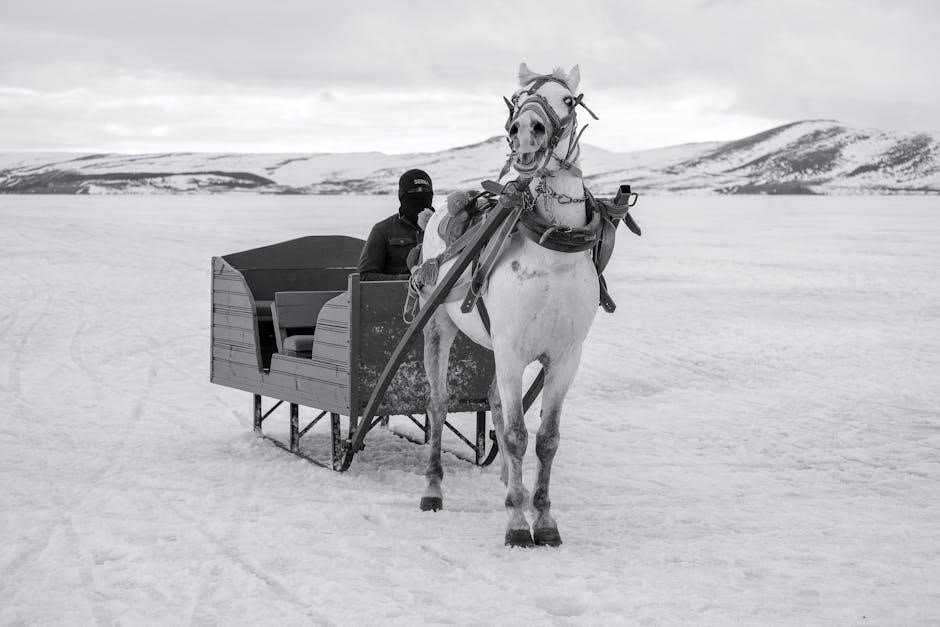
horse blanketing guide
Horse blanketing is an essential practice to protect your equine companion from harsh weather conditions. It ensures warmth‚ comfort‚ and well-being‚ especially during colder months or heavy rain.
Understanding when and how to blanket your horse is crucial‚ as it depends on factors like coat thickness‚ living situation‚ and overall health. A well-chosen blanket can make a significant difference in your horse’s comfort and safety.
When to Blanket Your Horse
Blanketing depends on coat thickness‚ living conditions‚ and temperature. Generally‚ horses need blankets when temperatures drop below 50°F‚ especially if they have a summer coat or are clipped.
Factors Influencing Blanketing Decisions
Several factors determine whether a horse needs blanketing. Coat thickness is a primary consideration; horses with a thick winter coat may not need heavy blankets in milder cold. Living conditions‚ such as access to shelter‚ also play a role. Horses kept outdoors in harsh weather may require more protection than those in warm stables. Age and health are important too; older horses or those with medical conditions may need extra warmth. Additionally‚ a horse’s digestive health and body condition influence blanketing decisions‚ as some may need more insulation to stay comfortable. Understanding these factors ensures you make informed choices for your horse’s comfort and well-being.
Temperature Guidelines for Blanketing
Temperature plays a crucial role in deciding when to blanket your horse. Generally‚ horses may need a blanket when temperatures drop below 50°F‚ but this varies based on individual factors. A horse with a thick winter coat might not need blanketing until temperatures fall below 30°F‚ while a clipped horse may require a blanket sooner‚ around 40°F. Light blankets are suitable for temperatures between 40°F and 50°F‚ medium-weight blankets for 30°F to 40°F‚ and heavy blankets for below 30°F. However‚ these are general guidelines and should be adjusted based on your horse’s specific needs. Always consider your horse’s comfort and adjust blanketing accordingly to prevent overheating or chilling.

Choosing the Right Blanket
Selecting the right blanket involves considering denier ratings‚ material types‚ and weight options. Light‚ medium‚ and heavy blankets cater to varying temperatures‚ ensuring optimal comfort and protection for your horse.
Understanding Blanket Weights and Warmth Levels
Blanket weights are categorized as light‚ medium‚ and heavy‚ providing varying levels of warmth. Light blankets are ideal for mild temperatures‚ offering minimal insulation‚ while medium weights are suitable for cooler conditions. Heavy blankets are designed for extreme cold‚ offering maximum warmth and protection. The choice depends on the horse’s coat thickness‚ climate‚ and individual needs. Proper selection ensures the horse stays comfortable without overheating or feeling too chilly. Understanding these weight options helps in making informed decisions for your horse’s seasonal comfort and well-being. Always consider your horse’s specific requirements to choose the appropriate blanket weight and ensure optimal warmth. This balance is key to maintaining their health and happiness throughout the year.
Denier Ratings and Material Selection
Denier ratings indicate the strength and weight of the fabric used in horse blankets. Higher denier ratings‚ such as 1200D or 1680D‚ signify more durable and rip-resistant materials‚ ideal for harsh weather conditions. Lightweight options like 600D are suitable for milder climates. Materials such as ripstop polyester and nylon are popular for their waterproof and breathable properties‚ ensuring the horse stays dry and comfortable. When selecting materials‚ consider the horse’s lifestyle‚ climate‚ and specific needs. Durable fabrics are essential for outdoor horses exposed to rough conditions‚ while lighter materials are better for indoor or temperature-sensitive horses. Always prioritize waterproofing to protect against rain and moisture. By choosing the right denier and material‚ you can ensure your horse’s blanket provides both comfort and protection throughout the season.

Proper Blanket Fit

A well-fitting blanket ensures comfort and prevents rubs or sores. Measure your horse from chest to tail for the correct size‚ and ensure the blanket lies flat without restricting movement.
Measuring Your Horse for the Correct Size
To ensure a proper fit‚ measure your horse from the center of the chest to the edge of the tail. This ensures the blanket is neither too tight nor too loose. Use a soft‚ flexible measuring tape or a string to get an accurate measurement. Stand the horse on level ground and make sure they are standing naturally without tension. The measurement should be taken along the horse’s side‚ following the natural curve of the body. This method helps determine the correct size‚ preventing discomfort and ensuring the blanket stays in place effectively. Accurate sizing is essential for your horse’s comfort and safety‚ especially during cold or wet weather.
Ensuring a Comfortable and Safe Fit
A well-fitting blanket is essential for your horse’s comfort and safety. When placing the blanket‚ start at the front and work your way back to avoid startling the horse. Fold the blanket in thirds and gently lay it over the horse’s back‚ ensuring it rests evenly. A proper fit should not cause rubs or sores‚ and the blanket should not bind around the neck or restrict movement. Always check for signs of discomfort‚ such as pulling away or restlessness‚ and adjust the fit if necessary. The blanket should lie flat along the horse’s body‚ with enough room to move freely. Regularly inspect the blanket for wear and tear‚ and make adjustments as needed to ensure your horse stays comfortable and secure.
Blanket Materials and Durability
Durable materials like ripstop polyester and nylon are popular for horse blankets due to their strength and resistance to tears‚ ensuring longevity and protection against harsh weather conditions.
Waterproof and Breathable Fabrics
Waterproof and breathable fabrics are essential for horse blankets to prevent moisture buildup while keeping your horse dry and comfortable. These materials ensure rain and snow stay out‚ reducing the risk of chilling. Breathability allows sweat to escape‚ preventing skin irritation and discomfort. High-quality options like ripstop polyester with waterproof coatings are durable and effective. Proper airflow helps maintain your horse’s natural temperature regulation‚ making these fabrics a crucial choice for varying weather conditions. Always look for materials that balance waterproofing and breathability to ensure your horse stays warm‚ dry‚ and comfortable throughout the seasons. This combination is vital for optimal health and well-being.

Maintenance and Care
Regular cleaning and proper storage of horse blankets are crucial for longevity. Use mild detergents to avoid damaging materials and store in dry‚ ventilated areas to prevent mold and mildew.
Cleaning and Storage Tips
Proper cleaning and storage of horse blankets ensure durability and prevent damage. Start by brushing off dirt and debris before washing. Use mild detergents‚ avoiding bleach‚ to clean the blanket. Air-dry or tumble dry on low heat to prevent shrinkage; For storage‚ fold or roll the blanket neatly and keep it in a dry‚ well-ventilated area to avoid mold and mildew. Avoid storing in direct sunlight to prevent fading. Regular maintenance helps extend the life of the blanket and keeps it in good condition for future use. Proper care ensures your horse stays comfortable and protected season after season.
Related posts:
Archives
- November 2025
- October 2025
- September 2025
- August 2025
- July 2025
- June 2025
- May 2025
- April 2025
- March 2025
- February 2025
- January 2025
- December 2024
- November 2024
- October 2024
- September 2024
- August 2024
- July 2024
- June 2024
- May 2024
- April 2024
- March 2024
- February 2024
- January 2024
- December 2023
- November 2023
- October 2023
- September 2023
- August 2023
- July 2023
- June 2023
- May 2023
Leave a Reply
You must be logged in to post a comment.